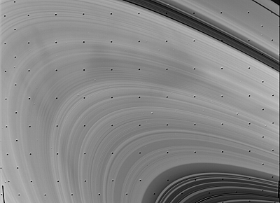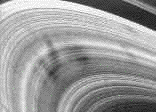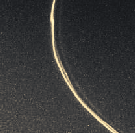The Rings of
Saturn
 The ring system of Saturn is divided into 5 major components: the G, F, A, B, and C rings,
listed from outside
to inside (but in reality, these major divisions
are subdivided into thousands of individual ringlets).
The F and G rings are thin and difficult to see, while the A, B, and C rings are broad and
easily visible. The large gap between the A ring and and the B ring is called the Cassini
division.
The ring system of Saturn is divided into 5 major components: the G, F, A, B, and C rings,
listed from outside
to inside (but in reality, these major divisions
are subdivided into thousands of individual ringlets).
The F and G rings are thin and difficult to see, while the A, B, and C rings are broad and
easily visible. The large gap between the A ring and and the B ring is called the Cassini
division.
The adjacent image
is a rare view of Saturn's rings seen just after the Sun has set below
the ring plane, taken with the Hubble Space Telescope on Nov. 21, 1995.
This perspective is unusual because the Earth is slightly above
and the Sun slightly below the rings. Normally we see the rings
fully illuminated by the Sun.
Three bright ring features are seen: the F Ring, the Cassini
Division, and the C Ring (moving from the outer rings to the inner). The low
concentration of material in these rings allows light from the Sun to shine
through them. The A and B rings are much denser, which limits the amount of
light that penetrates through them. Instead, they are faintly visible because
they reflect light from Saturn's disk
(Ref).
Ring Structure and Composition
 High
resolution photographs from the Voyager missions indicate that the rings of
Saturn are composed of hundreds of
thousands of "ringlets", and that regions like the
largest "gap" called the Cassini division, also contain fainter rings
(adjacent image). The rings cannot be solid, because they lie inside the
Roche limit. They presumably represent
either a satellite torn apart by tidal forces, or (more likely) material that
was never allowed to condense into moons because of the tidal forces.
The evidence indicates
that the rings are composed of particles that are mostly ice crystals, with
sizes as large as centimeters or meters.
The total mass in the rings is about the size of a medium mass moon, and the
rings are only about 12 m thick.
High
resolution photographs from the Voyager missions indicate that the rings of
Saturn are composed of hundreds of
thousands of "ringlets", and that regions like the
largest "gap" called the Cassini division, also contain fainter rings
(adjacent image). The rings cannot be solid, because they lie inside the
Roche limit. They presumably represent
either a satellite torn apart by tidal forces, or (more likely) material that
was never allowed to condense into moons because of the tidal forces.
The evidence indicates
that the rings are composed of particles that are mostly ice crystals, with
sizes as large as centimeters or meters.
The total mass in the rings is about the size of a medium mass moon, and the
rings are only about 12 m thick.
Spokes and other Structure
 It was expected that collisions between ring particles would tend to make the
rings uniform, but Voyager I found changing structures in the radial direction
that are termed "spokes". Some of this structure is shown in the adjacent
animation. It is thought that
gravitational forces alone cannot account for the spoke structure, and it has
been proposed that electrostatic repulsion between ring particles may play a
role.
It was expected that collisions between ring particles would tend to make the
rings uniform, but Voyager I found changing structures in the radial direction
that are termed "spokes". Some of this structure is shown in the adjacent
animation. It is thought that
gravitational forces alone cannot account for the spoke structure, and it has
been proposed that electrostatic repulsion between ring particles may play a
role.
 The Voyagers found that the rings were not necessarily circular, and even found
rings that appeared to be braided (adjacent image). They found further that
the outer ring was kept in place by the gravitational interaction of two small
"shepherd moons"
lying just inside and
outside it, and that at least some of the other
rings are kept narrow by similar small shepherding satellites. Generally,
although we have increased immensely our knowledge of the rings of Saturn over
the last 2 decades, we still do not fully understand their structure, dynamics,
or origin.
The Voyagers found that the rings were not necessarily circular, and even found
rings that appeared to be braided (adjacent image). They found further that
the outer ring was kept in place by the gravitational interaction of two small
"shepherd moons"
lying just inside and
outside it, and that at least some of the other
rings are kept narrow by similar small shepherding satellites. Generally,
although we have increased immensely our knowledge of the rings of Saturn over
the last 2 decades, we still do not fully understand their structure, dynamics,
or origin.
Here is some other info on
saturns rings
 The ring system of Saturn is divided into 5 major components: the G, F, A, B, and C rings,
listed from outside
to inside (but in reality, these major divisions
are subdivided into thousands of individual ringlets).
The F and G rings are thin and difficult to see, while the A, B, and C rings are broad and
easily visible. The large gap between the A ring and and the B ring is called the Cassini
division.
The ring system of Saturn is divided into 5 major components: the G, F, A, B, and C rings,
listed from outside
to inside (but in reality, these major divisions
are subdivided into thousands of individual ringlets).
The F and G rings are thin and difficult to see, while the A, B, and C rings are broad and
easily visible. The large gap between the A ring and and the B ring is called the Cassini
division.
 High
resolution photographs from the Voyager missions indicate that the rings of
Saturn are composed of hundreds of
thousands of "ringlets", and that regions like the
largest "gap" called the Cassini division, also contain fainter rings
(adjacent image). The rings cannot be solid, because they lie inside the
Roche limit. They presumably represent
either a satellite torn apart by tidal forces, or (more likely) material that
was never allowed to condense into moons because of the tidal forces.
The evidence indicates
that the rings are composed of particles that are mostly ice crystals, with
sizes as large as centimeters or meters.
The total mass in the rings is about the size of a medium mass moon, and the
rings are only about 12 m thick.
High
resolution photographs from the Voyager missions indicate that the rings of
Saturn are composed of hundreds of
thousands of "ringlets", and that regions like the
largest "gap" called the Cassini division, also contain fainter rings
(adjacent image). The rings cannot be solid, because they lie inside the
Roche limit. They presumably represent
either a satellite torn apart by tidal forces, or (more likely) material that
was never allowed to condense into moons because of the tidal forces.
The evidence indicates
that the rings are composed of particles that are mostly ice crystals, with
sizes as large as centimeters or meters.
The total mass in the rings is about the size of a medium mass moon, and the
rings are only about 12 m thick.
 It was expected that collisions between ring particles would tend to make the
rings uniform, but Voyager I found changing structures in the radial direction
that are termed "spokes". Some of this structure is shown in the adjacent
animation. It is thought that
gravitational forces alone cannot account for the spoke structure, and it has
been proposed that electrostatic repulsion between ring particles may play a
role.
It was expected that collisions between ring particles would tend to make the
rings uniform, but Voyager I found changing structures in the radial direction
that are termed "spokes". Some of this structure is shown in the adjacent
animation. It is thought that
gravitational forces alone cannot account for the spoke structure, and it has
been proposed that electrostatic repulsion between ring particles may play a
role.
 The Voyagers found that the rings were not necessarily circular, and even found
rings that appeared to be braided (adjacent image). They found further that
the outer ring was kept in place by the gravitational interaction of two small
"shepherd moons"
lying just inside and
outside it, and that at least some of the other
rings are kept narrow by similar small shepherding satellites. Generally,
although we have increased immensely our knowledge of the rings of Saturn over
the last 2 decades, we still do not fully understand their structure, dynamics,
or origin.
The Voyagers found that the rings were not necessarily circular, and even found
rings that appeared to be braided (adjacent image). They found further that
the outer ring was kept in place by the gravitational interaction of two small
"shepherd moons"
lying just inside and
outside it, and that at least some of the other
rings are kept narrow by similar small shepherding satellites. Generally,
although we have increased immensely our knowledge of the rings of Saturn over
the last 2 decades, we still do not fully understand their structure, dynamics,
or origin.